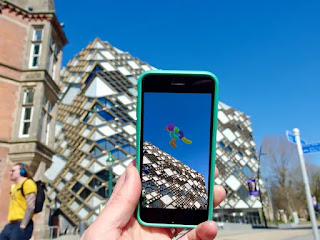In February, Sheffield launched one of the world’s biggest AR art trails. Titled “Look Up!,” the trail counts four buildings, each of them paired with a QR code on the sidewalk below. Using a free app, viewers can scan that QR code to follow a bunch of animated arrows that lead their gaze upward. There, from the roof of a building, they can watch a stick figure made of different-colored balloons drift up, swirl around, and fade into the sky—all through their phone’s screen. In the week following the launch, over 1,500 people had downloaded the app and almost 2,000 QR codes had been scanned.
The platform and app were created by a local company called Megaverse, which worked closely with Niantic, the San Francisco company behind Pokémon Go. The virtual artworks were created by two other local firms: Universal Everything and Human Studio. The impetus of the project goes back to a single building located smack dab in the middle of Sheffield. The John Lewis department store had been an anchor in Sheffield since the 1960s, when the building was still known as the Cole Brothers store. And then the pandemic hit, the store closed, and John Lewis withdrew from the building.
More information:
https://www.wired.com/story/sheffield-uk-augmented-reality-art-look-up/


